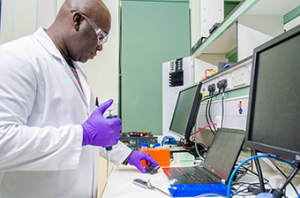Gene sequencing: Oxford Nanopore Technologies

Nanopore sequencing for the direct electronic analysis of single molecules.
Oxford Nanopore Technologies is developing molecular sensing technology using nanopores, for multiple applications including DNA sequencing.
CEO Gordon Sanghera says:
‘The company aims to deliver the next generation of DNA sequencing tool, to be to genomic medicine what broadband was to the internet.’
The company was spun out by Isis in 2005 – raising £0.5m from seed investors. It was founded on nanopore research from Professor Hagan Bayley’s group at Oxford’s Department of Chemistry.
Sanghera says:
‘The area of genome sequencing is attracting a lot of attention. At the moment it is very time consuming and expensive to sequence DNA, and yet researchers need this genetic information if they are to conduct thorough genomic research and develop new, targeted and personalised medicines.’
The company has successfully raised multiple rounds of investment from institutional and private investors.
In contrast to current technologies, the Oxford Nanopore sequencing system has the potential to measure single molecules without the need for chemical labels, therefore avoiding the use of expensive reagents and time-consuming amplification steps. Direct electrical measurement of the DNA sequence allows simpler instrumentation and data processing.
Nanopores may be used for the analysis of DNA or other nucleic acids, but also for the identification of many other molecules.
Applications include:
-
sequencing of DNA and other nucleic acids for medical research and the development of new drugs and treatments strategies, also applications outside human health for example, agriculture and energy
-
rapid detection of chemical or biological molecules for security and defence
-
accurate detection of biological markers for diagnostics, including infectious diseases with high impact on global health, such as Hepatitis C and the flu virus
-
ion channel screening
-
label-free analysis of interactions between biological molecules – for example, nanopore technologies may be adapted to analyse antibody-epitope, protein-DNA, protein-protein or protein-sugar interactions

